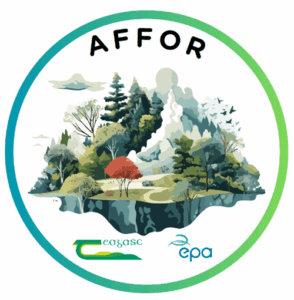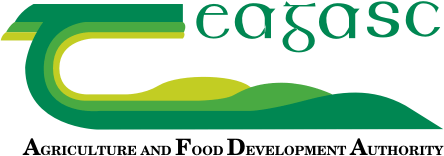
This project is funded under the EPA Research Programme 2021-2030. The EPA Research Programme is a Government of Ireland initiative funded by the Department of the Environment, Climate and Communications.
The primary objective of the project is to provide information for farmers, advisers and policy makers on the relative trade-offs of planting different forest types. The AFFOR project develops a comprehensive national forest modelling framework to evaluate the (private) timber returns and public (social) impacts on forest carbon sequestration and forest biodiversity of converting agricultural land in Ireland to:
- A fast-growing conifer forest (Sitka spruce)
- A fast-growing broadleaf forest (birch)
- A slow-growing broadleaf (oak) forest
Ireland’s agriculture is dominated by ruminant livestock systems, which account for one-third of national greenhouse gas (GHG) emissions. At the same time, a considerable area of grassland is marginal for agriculture and could provide a better financial return in forestry, with the added bonus of storing (sequestering) carbon in the forest and avoiding agricultural GHG emissions on the planted land. Harnessing this potential requires an understanding of how economic incentives, carbon values, biodiversity impacts, and farm heterogeneity shape land-use decisions.
Combining bioeconomic modelling, carbon accounting, forest and agricultural biodiversity assessments and a value chain analysis of the impact of afforestation in the local economy, AFFOR provides a robust, farm-level evidence base to inform afforestation policies aligned with Ireland’s climate, biodiversity, and rural development objectives.
The model integrates detailed microdata from the Teagasc National Farm Survey (NFS), forest growth and yield data, carbon price trajectories, and biodiversity expert assessments to quantify trade-offs and synergies across economic, environmental, and social dimensions.
AFFOR supports targeted, evidence-based policy design to accelerate afforestation and enhance its contribution to national and EU climate and biodiversity goals.
Background
Afforestation is central to Ireland’s climate change mitigation strategy, EU Green Deal targets, and the EU Forest Strategy’s ambition to plant 3 billion trees by 2030. Farm forests can sequester carbon, enhance biodiversity and deliver multiple ecosystem services while also providing economic opportunities for landowners. However, Ireland’s annual afforestation rates have declined significantly since 2010, jeopardising climate and biodiversity targets.
AFFOR addresses this challenge by integrating economic, carbon, and biodiversity modules into a unified modelling framework. AFFOR builds on earlier Teagasc forest bioeconomic models and the Teagasc (FIVE) forest valuation tool, which provides forest costs and incomes and utilises Teagasc National Farm Survey (NFS) data and EPA National Inventory Report (NIR, 2018), to generate farm-level analyses of afforestation financial and carbon returns. Combined with expert surveys of biodiversity value, this facilitates evidence-based policy interventions to promote land-use change in line with national and EU climate goals.
Project aims
- Develop a national afforestation model that integrates private economic returns, carbon sequestration values and biodiversity outcomes.
- Quantify the trade-offs and synergies between forestry and agriculture at farm, regional and national levels.
- Assess the distribution of private and social returns to afforestation across heterogeneous farm types, soil classes and yield categories.
- Incorporate expert-based biodiversity scoring into afforestation decision analysis.
- Evaluate the effects of carbon pricing, discount rates, and policy incentives on afforestation viability.
- Support targeted, farm-specific policy design to enhance afforestation uptake and maximise climate and biodiversity benefits.
Research focus
- Economic analysis: Net Present Value (NPV) and Annual Equivalised NPV (AE-NPV) for forestry and agriculture.
- Carbon modelling: Carbon sequestration in above- and below-ground biomass, harvested wood products (HWP), soil and dead organic matter, in tandem with displaced agricultural emissions.
- Biodiversity assessment: Expert-elicited biodiversity scores for afforestation scenarios across farm systems, species, soil types, and forest canopy stages.
- Farm heterogeneity: Distributional analysis of returns across diverse farm types, stocking densities and spatial contexts.
- Policy evaluation: Impacts of carbon pricing, afforestation incentives, and ecosystem service payments on land-use decisions.
Methodology
AFFOR employs a microsimulation approach, combining outputs from the ForBES (Ryan & O’Donoghue, 2016) and C-ForBES (Ryan & O’Donoghue, 2021) models with microdata from the Teagasc National Farm Survey (NFS). Key components include:
- Economic modelling: Simulation of counterfactual income streams by replacing one hectare of livestock agriculture with forestry on equivalent soils, accounting for timber revenues, subsidies, and forgone agricultural income.
- Carbon accounting: Application of IPCC (2006) guidelines and National Inventory Report (NIR, 2018) emission factors to estimate forest carbon sequestration and displaced agricultural emissions over a 200-year time horizon.
- Annualisation: Conversion of long-term forest NPVs into annual equivalised values (AE NPV) to enable comparison with annual agricultural incomes.
- Biodiversity integration: Delphi and expert survey methods generate biodiversity values for different forest types (species), soils, management and canopy closure stage, along with the change in floral biodiversity on different farm types and grazing intensities as a result of the transition from agricultural land to Sitka spruce, birch, or oak forests.
- Distributional analysis: Uncover the impact of farm heterogeneity (system, demographics, environmental context) on private (financial) and (public (social) return to farm afforestation.
Project outputs
- A comprehensive National Afforestation Model (AFFOR) integrating economic, carbon and biodiversity modules.
- Quantitative estimates of private and social returns to afforestation across soils, yield classes, farm systems and carbon price scenarios.
- Biodiversity scorecards for forest transitions, enabling integrated assessment of land-use change impacts.
- Evidence-based recommendations for afforestation policy design, including carbon pricing, subsidy reform, and ecosystem service payments.
- Dissemination materials developed by Teagasc Forestry Development Department to highlight the trade-offs of planting an indicative conifer species (Sitka spruce), fast-growing broadleaf (birch) and slow-growing broadleaf (oak), across income, carbon biodiversity and time to maturity dimensions.
Learn more about the AFFOR – National Afforestation Model project here
Impact, relevance and benefits
AFFOR provides Ireland’s first integrated farm afforestation modelling framework to assess the full spectrum of afforestation impacts at farm level. Its outputs inform climate, land-use, and biodiversity policies by:
- Highlighting the conditions under which afforestation is privately and socially profitable.
- Demonstrating the transformative effect of carbon pricing on afforestation returns.
- Guiding the targeting of incentives to maximise uptake on marginal agricultural land.
- Supporting Ireland’s contribution to EU Green Deal, EU Forest Strategy, and Paris Agreement commitments.
- Enhancing public understanding of afforestation’s role in delivering climate mitigation, biodiversity gains, and rural economic resilience.
Project partners
Teagasc – Rural Economy & Development Programme (Ireland)
- Dr. Mary Ryan
- Dr. Merve Kurt
- Dr. Kevin Kilcline
- Tom Houlihan
- Áine Moran
- Dr Niall Farrelly
University of Galway – Disciplines of Geography & Economics
- Prof. Cathal O’Donoghue
Trinity College Dublin – Department of Botany (Ireland)
- Prof. Jane Stout
- Kate Harrington
Atlantic Technical University
- Dr James Moran
Funding
The AFFOR project is funded under the EPA Research Programme 2021–2030, co-funded by the Government of Ireland and aligned with national climate and biodiversity policy priorities. The programme supports research to inform evidence-based policy and accelerate Ireland’s transition to a low-carbon, climate-resilient society.
EPA disclaimer: “Although every effort has been made to ensure the accuracy of the material contained in this webpage, complete accuracy cannot be guaranteed. The Environmental Protection Agency does not accept any responsibility whatsoever for loss or damage occasioned or damages claimed to have been occasioned, in part or in full, as a consequence of any person acting, or refraining from acting, as a result of a matter contained in this webpage.”
